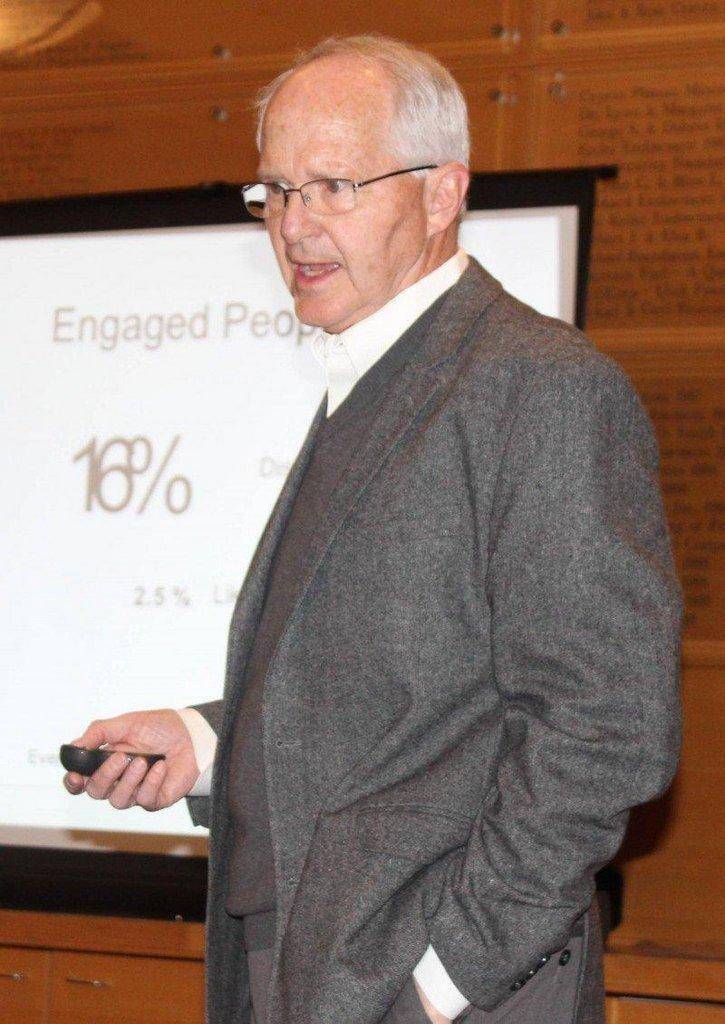Chuck Acklin presents to the BEAR general meeting on Feb. 18
Press Release
One of management’s biggest concerns in running a company is hiring and retaining the best employees possible. Regardless of the type of business, employees are a company’s biggest asset.
Chuck Acklin, of the VOLTI company, is out to help employers and employees alike when it comes to retention. During a presentation to the Business Expansion and Retention general board meeting on Feb. 18 he presented a tool to help keep employees, one that can shift a persons attitude, thus creating a more positive environment at work.
“Have you ever had ever had a good idea, but it seemed the world was stacked against you in pursuing it?” he asked the assembled group of over 40 people. “If you bring a good idea to the workplace only about 30 percent of the people that are exposed to it will engage with you enough to even hear what you are saying. And then only 25 percent of that group will like the idea. Sixteen percent will oppose it right away.”
He said because of this propensity, some people get stymied by these tendencies.
“Many get stuck into thinking that is all they can do, so why go any farther,” he said. “But you can go further than you think.”
At that point he had the audience do an exercise with each person standing up and doing a clock simulation by pointing to 12 and three on the clock with their right arms. He had them do that with their eyes open. Then he asked them to close their eyes and imagine they could go further than they did the first time and do it again. Almost everyone in the room realized they could stretch much further by doing this.
“By thinking in this way, we can take any situation we are in, look at what our limits have been, and then examine how we can go farther,” he told the group.
Acklin’s company’s philosophy is that when you shift attitudes and imagine where you can be, it will not only move a business forward, but will also improve the quality of the product, heighten employees focus, and will create innovation within the company.
He then introduced a small card which audience members could use to understand employees needs and wants and help them to grow in a direction that would be helpful to a business. Consisting of 11 boxes and steps, the process of filling it out and discussing the results can help a company to understand what is going on and focus employees on where they should be and want to be in the future. The boxes included:
- 1 Personal strengths: People list what they think is their strong points.
- 2 Personal wants: What a person really wants/what they think is important in life/work.
- 3 What a person thinks they can get: What a person gets out of the strengths and wants.
- 4 The benefits they derive from the first three steps: A one line benefit that comes from the above steps.
- 5 The personal payoff: The ultimate thing that is received from the ideas above.
- 6 The process to obtain the wants.
- 7 The results of the process.
- 8 and 9 If the results are enough or if not, what is desired.
- 10 What can be improved? If a person said yes to number 9 then they should note what can they improve to make it even better.
- 11 What a person can do differently to achieve the wants they desire if the answer was no.
“By doing this exercise, it opens up all kinds of opportunities toward improvement, particularly by examining what you are good at,” said Acklin. “The right thing to do is to concentrate on the positive. For instance think of someone in your life that constantly irritates you and look for the good qualities in them instead of concentrating on the ones that bother you.”
He also pointed out that if a person believes they are getting enough of what they want, that level of satisfaction is not going to stay there.
“Negatives can bring you down,” he said. “We need to get rid of the ‘buts’ in our lives. Instead of saying ‘I want a new car, but I can’t afford it’ we should say instead ‘I want a new car and I haven’t figured out how to afford it yet.'”
It was pointed out that attitude is a cycle or process, not a destination. Everyone should focus on their strengths, find new ones and record them.
In the final analysis, Acklin says that people should write down what they are grateful for, because that will reinforce a positive outlook.
“This will help you to close the gap between where you are and where you want to be in the future,” he concluded.

